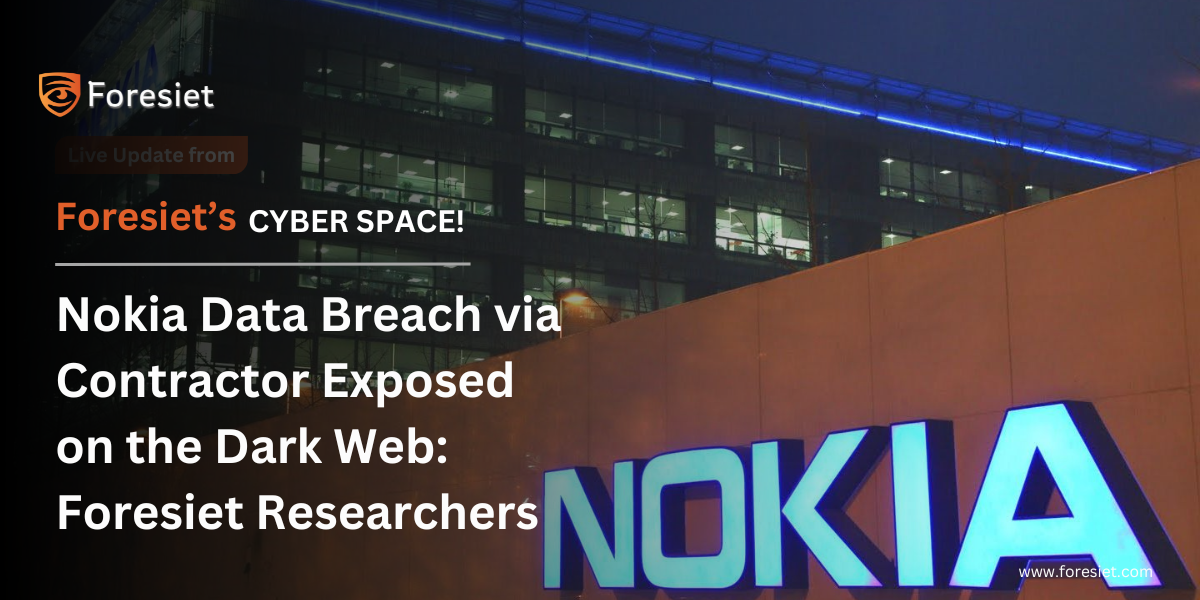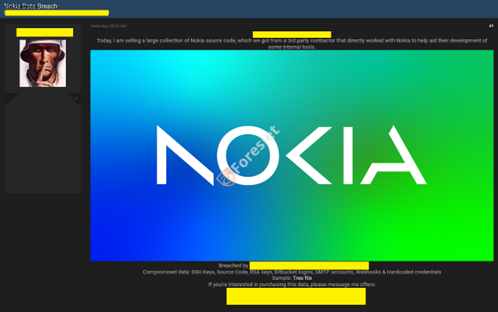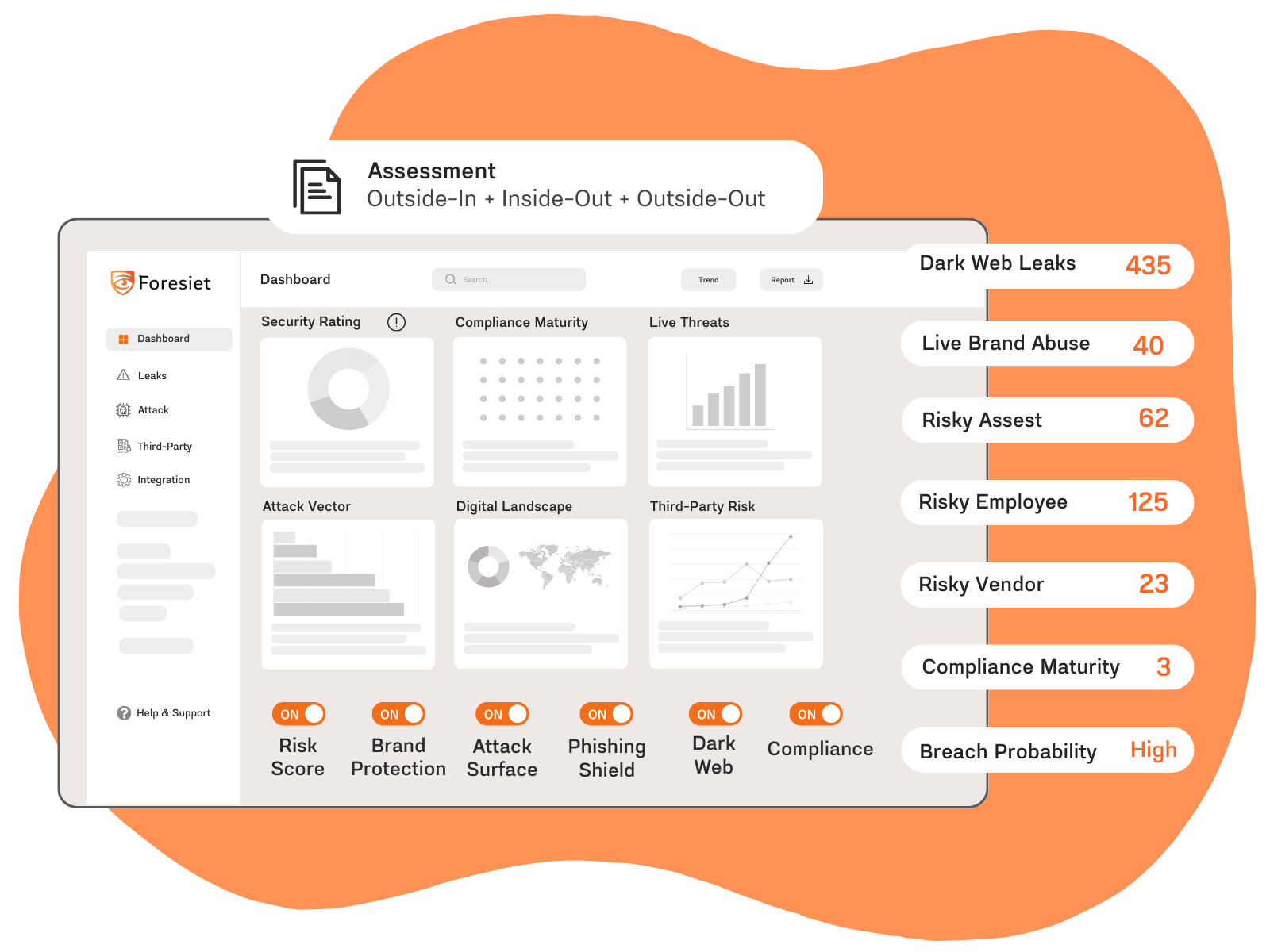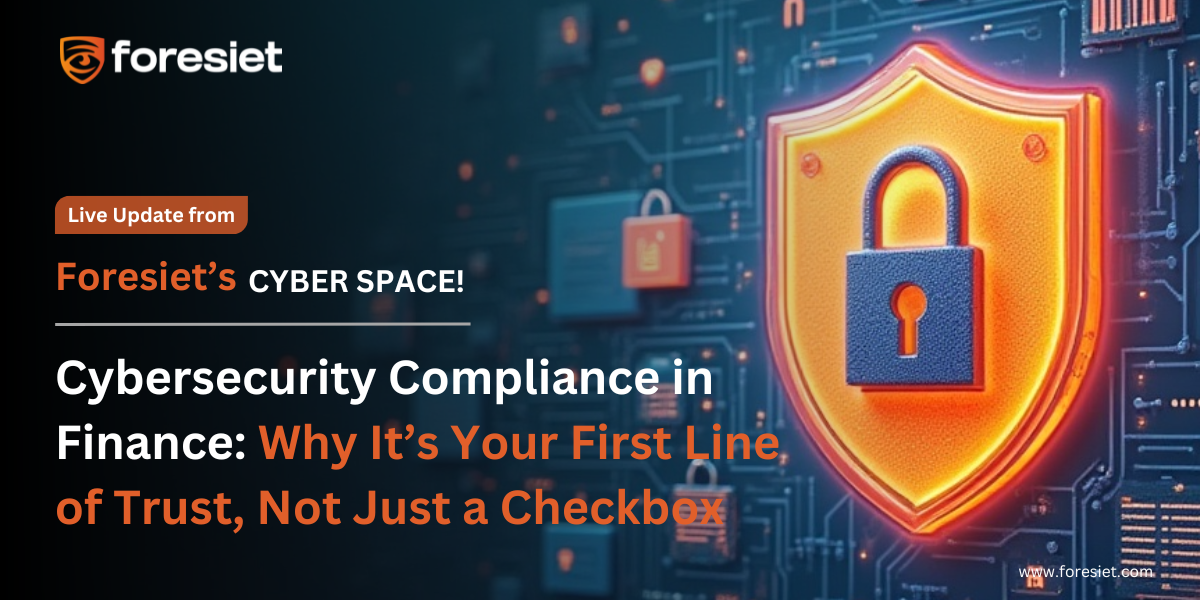Nokia Data Breach via Contractor Exposed on the Dark Web: Foresiet Researchers

Introduction
In recent events, Foresiet researchers identified a significant data leak involving Nokia's internal resources posted on a dark web marketplace. This leak, allegedly stemming from a third-party contractor working closely with Nokia on internal tool development, brings to light both sensitive code repositories and critical access credentials. Compromised data includes SSH keys, RSA keys, source code, Bitbucket login details, SMTP accounts, webhooks, and hardcoded credentials, potentially jeopardizing Nokia’s internal infrastructure.

The screenshot shows information about a breach on the dark web
This blog explores the details of the compromised data, breaking down key elements of the leaked code and theorizing how such a breach may have occurred. Finally, we discuss potential mitigation strategies Nokia and similar companies could adopt to protect their systems against similar exposures in the future.
Detailed Analysis of the Compromised Data
Upon investigation, Foresiet researchers identified a structured collection of highly sensitive information within the compromised files. This data breach exposed several critical components essential to Nokia’s system security and operational integrity.
- SSH and RSA Key Exposure:
SSH and RSA keys were among the core items compromised in this breach. These keys facilitate encrypted access to Nokia's systems, enabling secure communication and data transfers. However, the exposed keys now open the possibility for unauthorized users to bypass standard authentication protocols, granting direct access to Nokia’s critical servers and resources. The leaked data includes multiple SSH keys specifically designated for remote access to virtual machines and internal APIs, posing a serious security risk. - Proprietary Source Code for Internal Tools:
Source code for Nokia's internal operational and monitoring tools was also leaked on the dark web. This proprietary code includes infrastructure management and diagnostic tools, such as Airflow DAGs (Directed Acyclic Graphs), which are used to automate workflows. The exposure of such code gives malicious actors insights into Nokia’s internal architecture and processes, potentially enabling them to exploit vulnerabilities within these tools. - Bitbucket Logins and Repository Access:
The breach also included credentials for Bitbucket logins and repository access, which are essential for managing Nokia’s version control system. Unauthorized access to these credentials could allow attackers to modify or steal additional code repositories, jeopardizing software integrity. This access could also facilitate the insertion of malicious code, creating further vulnerabilities within Nokia’s systems. - Compromised SMTP Accounts and Webhooks:
SMTP account credentials and webhooks were among the items exposed. SMTP credentials, which facilitate email communication within Nokia's network, could allow attackers to conduct phishing attacks, impersonate employees, or intercept confidential communications. Webhooks, meanwhile, could be manipulated to transmit sensitive data externally or to control Nokia’s systems remotely, adding another layer of risk. - Hardcoded Credentials in Source Code:
Finally, hardcoded credentials embedded within the source code present a severe security vulnerability. These credentials often enable direct access to databases and services, bypassing additional authentication. Such exposure grants attackers straightforward entry to Nokia’s sensitive assets, underscoring the need to carefully monitor and address hardcoded credentials to prevent unauthorized access.
A recent file shared by a threat actor highlights the critical need for robust security practices in managing sensitive credentials and configurations. The file contained multiple SSH keys, environment configuration files, and custom libraries used in various ETL (Extract, Transform, Load) processes. Integral to data pipelines and secure server access, their exposure underscores how quickly attackers can exploit even minor lapses in data security.
This incident serves as a reminder of the importance of securing sensitive files with encryption, access controls, and regular audits. By safeguarding these elements, organizations can significantly reduce the risk of unauthorized access, data leaks, and service disruptions.
The Theory of the Breach
Based on our investigation, we have developed a working theory of how this breach may have unfolded. It likely began with the third-party contractor’s access to Nokia’s internal systems, which was necessary for their work on Nokia’s projects.
This access, however, may not have been tightly controlled, possibly allowing overly broad access permissions. A compromised contractor system could easily lead to an internal breach, especially if credentials were saved insecurely or improperly protected. Our researchers speculate that weak credential management, including the storage of login details within easily accessible configuration files, might have provided a clear path for unauthorized access.
If attackers gained access to these credentials, it would have been relatively simple for them to move through Nokia’s systems, extracting sensitive code and critical account details. By outlining this possible sequence, we aim to shed light on how external dependencies can create unexpected vulnerabilities.
Implications for Security Practices
This breach highlights some critical vulnerabilities that companies should address to reduce the risks tied to third-party contractors. Our findings underscore the importance of treating third-party access with extreme caution, limiting the permissions granted, and constantly monitoring such access. Additionally, the hardcoding of credentials within code and configuration files presents an urgent risk; organizations must implement practices to eliminate this habit entirely, adopting encrypted secrets management solutions instead.
In light of this incident, we also stress the need for automated monitoring of unusual access patterns, particularly for sensitive accounts and tools accessed by external partners. Security best practices should be extended to all contractors, ensuring they are fully trained in safeguarding sensitive data and adhering to secure coding standards.
The Nokia breach underscores the importance of these precautions, reminding organizations to regularly evaluate their security protocols and ensure all third-party relationships are meticulously managed and monitored.
Conclusion
The Foresiet research team is conducting a thorough analysis of this data breach to understand its full impact and implications. As part of our investigation, we shared a file tree of the allegedly stolen data with Nokia, seeking confirmation on whether the data originated from their systems. However, we have yet to receive a response.
Our ongoing research aims to uncover additional insights and identify critical areas for strengthening security measures. We are committed to providing a comprehensive view of the risks posed by this leak and offering actionable guidance to help organizations protect themselves against similar threats.
Stay connected with Foresiet for further updates, as we continue our investigation and work toward a more secure digital landscape. We will share relevant insights and recommendations as more information becomes available, helping organizations enhance their resilience against data breaches.
About us!
Foresiet is the pioneering force in digital security solutions, offering the first integrated Digital Risk Protection SaaS platform. With 24x7x365 dark web monitoring and proactive threat intelligence, Foresiet safeguards against data breaches and intellectual property theft. Our robust suite includes brand protection, takedown services, and supply chain assessment, enhancing your organization's defense mechanisms. Attack surface management is a key component of our approach, ensuring comprehensive protection across all vulnerable points. Compliance is assured through adherence to ISO27001, NIST, GDPR, PCI, SOX, HIPAA, SAMA, CITC, and Third Party regulations. Additionally, our advanced antiphishing shield provides unparalleled protection against malicious emails. Trust Foresiet to empower your organization to navigate the digital landscape securely and confidently.
Protect your brand, reputation, data, and systems with Foresiet's Integrated Digital Risk Platform. 24/7/365 threat monitoring for total peace of mind.


July 10, 2025, 9 a.m.
